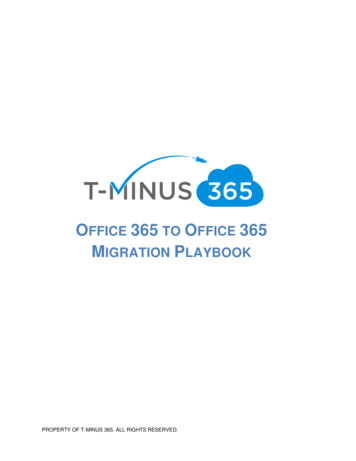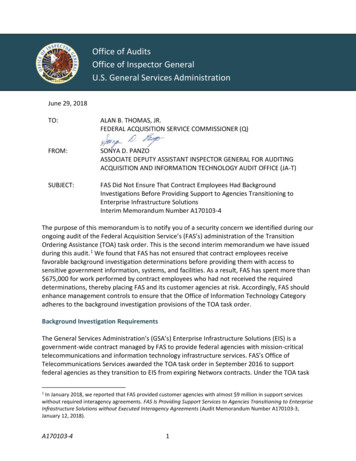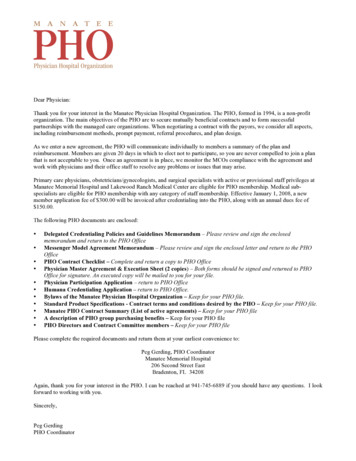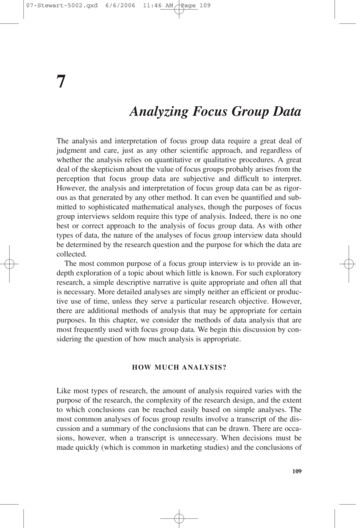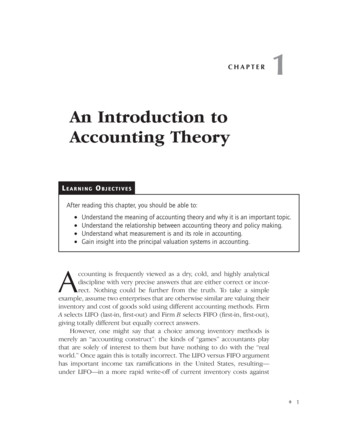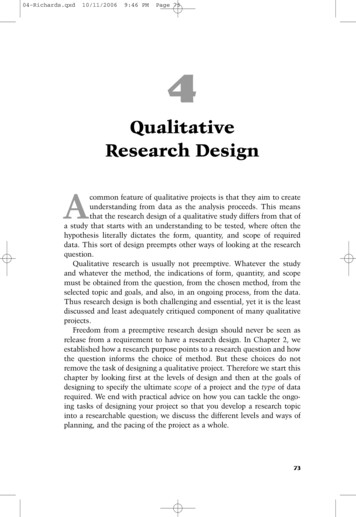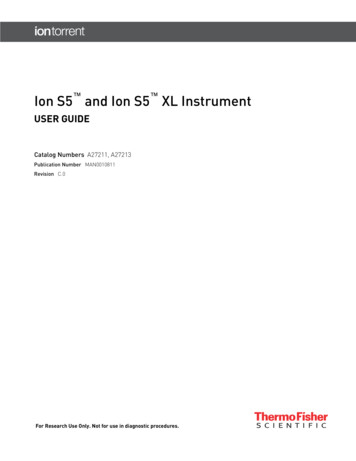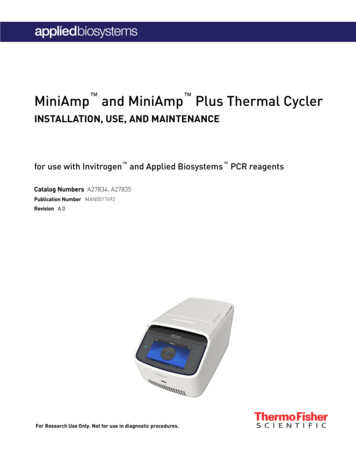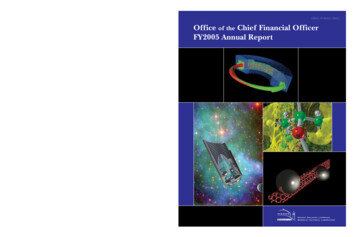
Transcription
LBNL/PUB-922 (2005)Office of the Chief Financial OfficerFY2005 Annual Report
LBNL/PUB-922 (2005)Office of the Chief Financial OfficerFY 2005 Annual ReportErnest Orlando Lawrence Berkeley National LaboratoryUniversity of CaliforniaBerkeley, CaliforniaJanuary 2006This work was supported by the Director, Office of Science of the U.S. Department of Energy underContract No. DE-AC02-05CH11231.
Table of ContentsChief Financial Officer’s Statement . 1Laboratory Organizational Chart . 31. Office of the Chief Financial Officer OrganizationsOCFO Organization Chart . 4Controller’s Office . 6Budget Office . 8Procurement & Property Management Department . 10Sponsored Projects Office 12Field Operations Office .132. Institutional InformationFigure 2.1 Where Did Your Program Dollars Go in FY 2005 17Table 2.1 Cost Trend by Expense Category, FY 2001 – FY 2005 . 18Table 2.2 Cost by Direct Funding Source by Division, FY 2001 – FY 2005 .19Table 2.2a Cost by Direct Funding Source by Division, FY 2005 . 19Table 2.2b Cost by Direct Funding Source by Division, FY 2004 . 20Table 2.2c Cost by Direct Funding Source by Division, FY 2003 . 20Table 2.2d Cost by Direct Funding Source by Division, FY 2002 . 21Table 2.2e Cost by Direct Funding Source by Division, FY 2001 . 21Table 2.3 Indirect Budget Costs by Division, FY 2005 ( K) . 22Table 2.4 Average FTE Breakdown by Division, FY 2005 . 233. Direct Funding – DOE and Reimbursable WorkTable 3.1 LBNL Fund Trends (BA) by Funding Source ( K) . 29Table 3.2 LBNL Cost Trends by Funding Source ( K) 30Table 3.3 Laboratory Funding and Costs by Source ( K) 31Table 3.4 Administrator for National Nuclear Security Administration ( K) . 32Table 3.5 DOE Programs . 33Table 3.6 Reimbursable Work-for-Other Federal Agencies( K) .40Figure 3.1 Sponsored Projects Office Information . 414. Indirect BudgetsFigure 4.1 Indirect Budgets, FY 2005 ( M) .45Figure 4.2 Institutional Overhead Costs as a Percentage of Operating Costs,FY 1994 – FY 2005 46Table 4.1 Institutional Costs by Division, FY 2005 ( K) . 47Table 4.2 Institutional FTEs Charged by Division FY 2005 47Figure 4.3 Payroll Burden Summary ( M) . 48Figure 4.4 Gross Payroll Summary FY 2005 ( M) . 48Table 4.3 Organizational Burden Costs and FTEs . 49Table 4.4 Service Center Costs and FTEs 49Table 4.5 Distributed Recharges by Resource Category Trends FY 2001 – FY 2005 ( K).50i
5. Financial StatementTable 5.1 Laboratory Balance Sheet . 53Notes to the Balance Sheet . 546. Procurement and Property Management InformationTable 6.1 Requisitions Submitted by Laboratory Divisions . 61Table 6.2 Purchases Placed Using Written Subcontracts . 62Table 6.3 Purchases Placed Using P-Card 62Table 6.4 Laboratory Socioeconomic Performance .63Table 6.5 Property Management Activity . 647. Data From Other LaboratoriesTable 7.1 Other DOE Laboratories for Which Financial Information is Available . 67Table 7.2 Summary Cost Data for DOE Laboratories, FY 2001- FY 2004 . 67Table 7.3 Overhead Information for DOE Laboratories, FY 2004 . 68Table 7.4 Overhead Costs as a Percentage of Operating Costs for DOE Laboratories 69Figure 7.1 Functional Support Cost as a Percentage of Total Cost, FY 2000-FY2004 708. Acronyms and Key TermsAcronyms and Key Terms 73ii
Chief Financial Officer’s StatementI am pleased to present the FY 2005 Chief Financial Officer’s (CFO) Annual Report and hopethat you will find it a useful reference tool. Data includes information from the Budget Office,the Controller, Procurement and Property Management, and the Sponsored Projects Office. Wehave also included some financial comparisons with other DOE laboratories along with aglossary of common acronyms.FY05 continued to be a time of financial change and growth for the Laboratory. Two Laboratoryfunctions were added to the OCFO organization. In June, Travel and Conferences, and PropertyManagement came under the OCFO umbrella. With the move of Property Management intoProcurement, we also hired a new leader for the Procurement Department. Another key hire forFY05 was the addition of a Controller. With these two new additions, the senior managementteam of OCFO is now complete and will allow us to provide even better service to the divisionsas well as greater financial assurance and expertise.FY05 was a year of financial accomplishments. The PeopleSoft 8.8 upgrade of our internalfinancial system, as well as the new DOE accounting system (STARS/IMANAGE), were bothimplemented. These major systems upgrades were performed with little disruption to everydayactivities for the divisions. An LBNL institutional cost distribution restructuring took place,resulting in a more equitable and transparent method of allocating costs, which will ensurealignment of good business practices with the Lab’s strategic mission. The OCFO developed anew financial policy and procedures manual as a resource for Laboratory employees, inaccordance with best practices and compliance with DOE and UC regulations. Training infinancial procedures and system tools was also conducted to enhance core competencies andincrease staff proficiencies to enable sound financial decision support for Laboratorymanagement.In Procurement, a new Small Business and Supplier Management Office was established toaggressively promote subcontracting opportunities for small and disadvantaged businesses and toexecute a new Supplier Management Plan. Also in FY05, a new Procurement Self-AssessmentPlan to evaluate both systems and transactions was implemented.The OCFO completed its five-year strategic plan outlining our approach to provide the greatestcapability for the least cost while continuing to provide the highest standard of professionalfinancial management for the Lab. Our approach includes organizational transformation, timelyand accurate reporting, assurances, benchmarking, creating and sustaining partnerships, anddeveloping human capital.FY06 will be challenging as budget uncertainties continue. Plans for FY06 financial systemsinclude utilization of the ePro PeopleSoft program for the Supply Chain initiative. This includesthe automation and the ability for employees to procure via Business to Business contracts, andto receive electronic invoices and payments from vendors. The Budget Office will continue towork with our IT professionals to implement a funds control system; and a redesign of the timeand-effort reporting system will be initiated. Financial management courses will be developed1
and offered to employees in FY06, as well as the development of additional, relevant financialpolicies and procedures.As assurances become more stringent, OCFO will focus its efforts on the implementation ofOMB Circular 123, the government-mandated regulation for assuring financial integrity.Fulfilling the promises of our strategic plan will also be a major part of our focus in the comingfiscal years.The information in this report was compiled by the Office of the Chief Financial Officer. Pleasedirect any questions or comments regarding this report to me or members of my staff. Wewelcome suggestions for improving this report as well as other ideas that will help us enhanceour financial management activities in support of the Laboratory’s mission.Jeffrey A. FernandezChief Financial OfficerLawrence Berkeley National Laboratory2
3
4
1. Office of the Chief Financial Officer Organization5
Michael CostelloControllerController’s OfficeThe responsibility of the Controller’s Office, led by Michael Costello, Controller, is to furnishtimely and accurate financial information to UC, DOE, and the Laboratory community. TheController’s Office is dedicated to delivering efficient and cost-effective financial and travelservices through a team of highly competent and dedicated professionals. It is also theController’s responsibility to ensure that the Lab has a strong internal control environment and isin compliance with government accounting standards and applicable laws and regulations.The Controller’s Office consists of the following groups:General Accounting:General Accounting (GA) provides overall coordination for the accounting activities at the Lab.GA is responsible for the monthly financial reporting to DOE and annual reporting to UC. GAhandles property accounting, banking relations, and coordinates monthly close activities withdivisions and OCFO departments.Payroll:Payroll is responsible for all bi-weekly and monthly pay cycles, and all employee payroll-relatedactivities. Payroll works to resolve all timekeeping issues and handles all federal and stateregulatory filings (IRS, Franchise Tax Board, etc.).Travel and Conference:The Travel Unit coordinates all travel services for the Lab including: travel reservations, travelagency liaison, expense voucher processing, DOE foreign travel documentation and approval,travel hotline, and Gelco system training. Conference Coordination manages all aspects of largeand small conferences, meetings, and symposiums including negotiating vendor contracts forhotels, conference space, food, and other conference services.Disbursements:Disbursements (Accounts Payable AP) ensure timely payment of all vendor and non-payrollrelated employee payment requests. AP maintains a strong system of controls to ensure properauthorization and documentation is received before payments are made.Accounts Receivable:Accounts Receivable (AR) provides billing and collection support for the Work-for-Othersprograms and projects. AR works closely with the Sponsored Projects Office to coordinatefinancial issues surrounding sponsors’ funding, advances, and billings.6
7
Minh Agon HuebnerBudget OfficerBudget OfficeMinh Agon Huebner, Budget Officer, leads a team of financial professionals dedicated toproviding high-quality products and services to DOE and LBNL internal partners in support ofeffective business decisions and sound financial management practices.The Budget Office consists of the following two groups:Direct Budget:The primary function of Direct Budget is to provide assurance that the formulation and executionof budgets complies with DOE requirements and remains within Non-DOE sponsors’ financialterms. Through interactions with DOE and in partnership with LBNL’s financial managementcommunity, Direct Budget facilitates funding issue resolutions, interprets DOE directives andguidance, and develops appropriate Lab financial policies.Indirect Budget:The primary function of Indirect Budget is to provide high-level oversight for indirect budgets.This oversight includes projecting the institutional indirect revenues, managing the indirectbudget formulation process, reviewing cost elements and allocation methodologies fordistributed budgets, performing related-cost impact analyses, and developing appropriate Labfinancial policies.8
9
Derrol HammerManager, Procurement & Property Management DepartmentProcurement & Property Management DepartmentThe Procurement & Property Management Department is responsible for the acquisition ofgoods and services, as well as the management of Laboratory assets that are necessary for theLaboratory to fulfill its scientific mission. Leading the department is Derrol Hammer, who washired in August 2005 to fill the newly formed Procurement & Property Manager position. Derrolwas most recently the Procurement Manager for the National Ignition Facility at LawrenceLivermore National Laboratory.The Procurement & Property Management Department consists of the following groups:Procurement & Property Manager Staff:This encompasses the management and administration of the Department as well as the SmallBusiness and Supplier Management Office. It is also responsible for procurement policy,assurance, and systems administration.R&D and Professional Services:The primary function of this group is the acquisition of consultant services, Joint GenomeInstitute (JGI) supplies, equipment and support, and R&D services contracts, including IntraUniversity Transfers (IUT).Commercial and Strategic Sourcing:The primary function of this group is the creation of system contracts (B2B) and development ofsupply-chain contracting.Construction and Institutional Support:The primary function of this group is the acquisition of construction and architect & engineeringservices. They are also responsible for institutional blanket subcontract requirements.Fabrications and One-time Purchases:The primary function of this group is the acquisition of mechanical and electrical fabrications,equipment and tools; electrical hardware; lab supplies; furniture, raw materials, and credit cardpurchases.Property Management:The Property Management group is responsible for all property management policies andsystems. They track all accountable and controlled property at the Lab, conduct allinventories of such items, as well as asset transaction management. In May 2005, JohnMorgan was hired to fill the Property Manager position. John comes with an extensivebackground in property management with DOE.10
11
Jeffrey WeinerManager, Sponsored Projects OfficeSponsored Projects OfficeThe Sponsored Projects Office (SPO) is headed by Jeffrey Weiner. SPO holds the delegatedauthority from The Regents (via the Lab Director) to submit proposals and negotiate and acceptawards from Non-DOE sponsors. The Sponsored Projects Office obtains the DOE approval forproposals and awards when necessary. Sponsored Projects has Contracts Officers (COs) whoserve all the Non-DOE research needs of their assigned divisions. SPO is organized by divisionso that most customers interact with only one SPO Contracts Officer. Sponsored Projects handlesthe following technology transfer agreements: Sponsored Research Agreements (Work for Others)Cooperative Research and Development Agreements (CRADAs)User AgreementsAgreements with other DOE labs, and Gifts.12
Charles AxthelmManager, Field Operations OfficeField Operations OfficeThe CFO Field Operations Office under the leadership of Charles Axthelm, Manager, consists ofapproximately 45 professional resource analysts matrixed to the Lab’s scientific and operationsdivisions.OrganizationField Operations resource analysts provide matrix organizations with customer-oriented projectresource management expertise. Their principal role is one of financial stewardship. Resourceanalyst responsibilities typically include budget preparation, budget execution and closeout, andfinancial consulting and advisory services. Resource analysts may also supervise other resourceanalysts and administrative staff, and may represent the matrix organization in meetings and onproject teams.13
14
2. Institutional Information15
16
Figure 2.1 Where Did Your Program Dollars Go in FY 2005LBNL Cost Breakdown per DollarDOEDOEIntegratedOperating Contractors Construction WFO NonCostsCostsand EquipmentDOEExpensesDirectDirect LaborUC Labor (a)Contract LaborOrg. Burden (b)Subtotal Direct Labor 0.37 0.00 0.06 0.43 0.44 0.00 0.07 0.51 0.13 0.00 0.02 0.16 0.38 0.00 0.06 0.45 0.17 0.11 0.02( 0.00) 0.01 0.02 0.33 0.01 0.03 0.00 0.00 0.14 0.02 0.21 0.41 0.36 0.00 0.00 0.01 0.00 0.78 0.12 0.08 0.01 0.01 0.03 0.02 0.27 0.75 0.72 0.94 0.72ProcurementTravelSpaceG&A (Other Inst.)Total Indirect 0.01 0.00 0.02 0.21 0.25 0.00 0.00 0.02 0.25 0.28 0.02 0.00 0.00 0.04 0.06 0.01 0.00 0.02 0.25 0.28Total Expenses 1.00 1.00 1.00 1.00Other DirectServicesMaterialsUtilitiesOther Expenses (c)Recharges (b,d)TravelSubtotal Other DirectTotal DirectIndirectNote: Minor variances may occur due to rounding.(a) UC Labor includes salary and benefits for Scientists/Engineers, Admin., Students/GSRA's and Campus Labor(b) Distributed activities used by direct funded programs.(c) Includes misc. expenses (stipends, sales tax, freight, etc.)(d) Includes recharges credited back to direct operating accounts such as ALS and Esnet (In FY04 Annual Reportthese were included in Other Expenses tOther DirectDirect sConstructionandEquipmentWFO NonDOE17
Table 2.1 Cost Trend by Expense Category, FY2001 – FY2005( M and % of Total)FY 2001ExpensesDirectDirect Labor MUC Labor (a)Contract LaborOrg. Burden (b)Subtotal Direct LaborFY 2002% MFY 2003% MFY 2004% MFY 2005% iesOther Expenses (c)Recharges (b,d)TravelSubtotal Other 89.4204.019.5%14.4%1.4%0.2%1.7%1.8%38.9%Total 523.7100.0%Other DirectIndirectProcurementTravel (e)SpaceG&A (Other Inst.)Total IndirectTotal ExpensesNote: Minor variances may occur due to rounding.(a) UC Labor includes salary and benefits for Scientists/Engineers, Admin., Students/GSRA's and Campus Labor(b) Distributed activities used by direct funded programs.(c) Includes misc. expenses (stipends, sales tax, freight, etc.)(d) Includes recharges credited back to direct operating accounts such as ALS and Esnet (In FY04 Annual Report these were included in Other Expenses category).(e) Prior to FY04 Travel was included in G&A (FY01) or Procurement Burden (FY02 - FY03).18
Table 2.2 Cost By Direct Funding Source by Division, FY 2001 – FY2005 ( K)DivisionAccelerator & Fusion ResearchAdvanced Light SourceChemical SciencesComputing Sciences *Computational Research *NERSC Center *Information Technology *Environmental Energy TechnologiesEngineeringEH&SEarth SciencesFacilitiesGenomicsLife SciencesMaterials SciencesNuclear SciencePhysical BiosciencesPhysicsLab Directorate/OtherOtherDivision TotalFY2001 FY2002 FY2003 FY2004 ,589478,705456,429503,730523,739Note: Minor variances may occur due to rounding.* Computer Science Divisions costs for FY 2001 thru FY2003 are based on FMS project tree as of 12/8/05Table 2.2a Cost By Direct Funding Source by Division, FY 2005 ( K)FY 2005DivisionAccelerator & Fusion ResearchAdvanced Light SourceChemical SciencesComputing SciencesComputational ResearchNERSC CenterInformation TechnologyEnvironmental Energy TechnologiesEngineeringEH&SEarth SciencesFacilitiesGenomicsGenomics - JGILife SciencesMaterials SciencesNuclear SciencePhys
management. In Procurement, a new Small Business and Supplier Management Office was established to aggressively promote subcontracting opportunities for small and disadvantaged businesses and to execute a new Supplier Management Plan. Also in FY05, a new Procurement Self-Assessment Plan t

